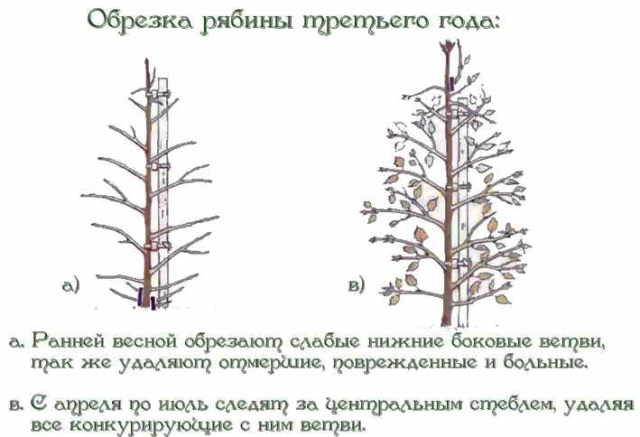Content
There are over 100 types of mountain ash described in science in the world. The dense crown of most of these trees and shrubs from early autumn to late winter is abundantly decorated with bright clusters of red, less often black fruits. However, there is also a white mountain ash. It is presented in only a few variants, the most famous of which are the Kene and Kashmir species, as well as the White Swan, a hybrid of common mountain ash. However, these plants are a real find for a landscape designer.
In order to grow white-fruited mountain ash in your garden, you should know what its species and varieties are characteristic of, in what conditions they prefer to grow and what care they require. And then a bright unusual tree, strewn with white berries against a background of greenery or crimson foliage, will become a spectacular decoration for any decorative planting.
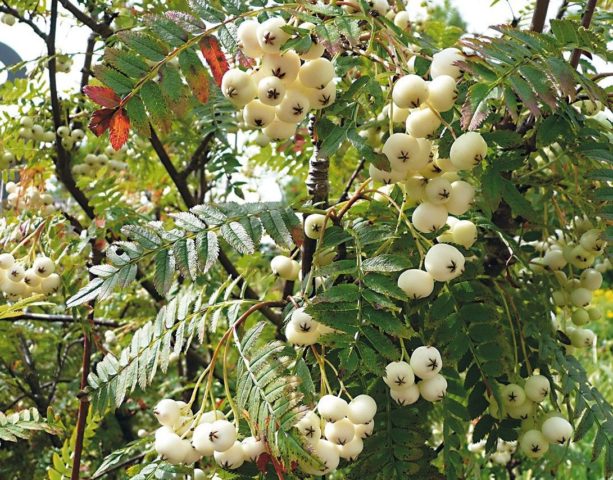
Rowan with white berries - an unusual decoration of the garden
Is there a white rowan
Rowan with white berries is a rare plant in Russia, but this is not a legend. It exists in the wild, hiding under the shade of mountain pine forests, for example, the Kene mountain ash, discovered by scientists in the warm climate of Central China, or the Kashmir tree, common in the Western Himalayas. There are also white-fruited varieties that have arisen as a result of the purposeful work of breeders. Having crossed an ordinary mountain ash with a two-colored one, they got a new hybrid - Arnold's mountain ash, which has many interesting variations with fruits of different colors. Among them is the ornamental variety White Swan, whose large berries resemble snow in color.
Types and varieties of white rowan
The types and varieties of white mountain ash listed above are morphologically somewhat different from each other. In this regard, each of them should be characterized separately.
Rowan Kene
Outwardly, the white rowan Kene resembles its ordinary "relative" a little, but is smaller and more graceful in appearance. In natural habitats, its height can reach 3 m, but in the climate of central Russia, it rarely grows above 2 m.
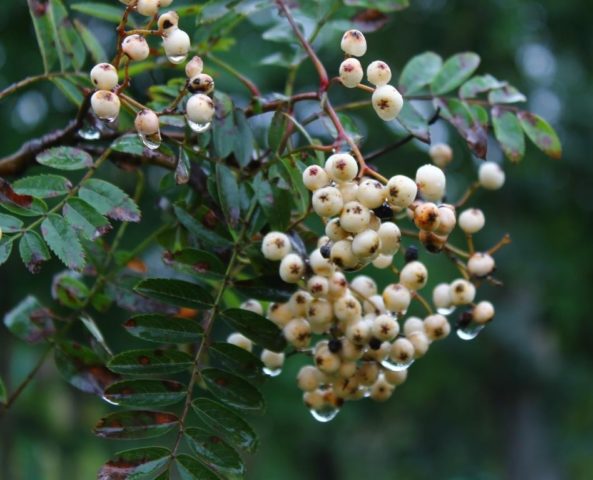
Kene white-fruited mountain ash is a species plant native to China
Kene White Rowan can be a large shrub or small tree. In cold conditions, a plant can simultaneously develop 2-3 trunks, but most often it is one - straight and smooth, covered with reddish-brown bark with small light "lenticels". The crown of Kene's mountain ash is openwork and wide, up to 4 m in diameter.
The leaves are long (from 10 to 25 cm), pinnate, consisting of 17-33 small elongated leaflets with jagged edges. Most of them are concentrated at the top of the plant.
White rowan Kene blooms for 10-12 days in late spring or early summer. The flowers are small, white, collected in loose corymbose inflorescences up to 12 cm in diameter.
At the end of summer, fruits ripen - the size of a pea (0.7 cm), milky white on red stalks, looking very impressive against the background of green and then purple foliage. Kene white rowan bears fruit every year. The berries are edible, do not taste bitter, but taste very sour. True, in the conditions of the Russian climate, it turns out to collect only a glass or two of white fruits during the season. This plant is appreciated mainly for its decorative qualities.
Brief information about the white mountain ash Ken is on the video:
White mountain ash Kashmir
Rowan Kashmir is more winter-hardy than Kene. In Russia, it can grow in the Central and Northwestern regions, up to the Leningrad Region, although in severe winters, annual increments can often freeze slightly.
In its homeland in the Himalayas, the Kashmir mountain ash can stretch up to 10 m in height. In domestic plantings, it usually grows only up to 4-5 m for 20 years. The diameter of its crown is about 3 m, the shape is pyramidal.
The bark of the plant is smooth, gray or reddish-gray. The complex alternate leaves of the white Kashmir mountain ash reach 15-23 cm in length, usually they consist of 17-19 leaves. Their upper part is dark green, the lower is colored lighter. In autumn, the leaves turn yellow, taking on reddish-brown and orange hues.
The flowers reach 1 cm in diameter, they are white-pink in color and are grouped in large umbrellas. The flowering period of the Kashmir mountain ash is the border of May-June.
The fruits are large, 1-1.2 cm in diameter (according to British nurseries - up to 1.4 cm), juicy, numerous. According to most sources, they are inedible due to their sour, bitter taste. Their color is usually waxy white, although sometimes it can be golden. Ripen in September-October.

Rowan Kashmir - a species that grows on the slopes of the Himalayas
Rowan white swan
Arnold's rowan variety White Swan is a straight-stemmed tree up to 7 m tall with a compact narrow conical crown (1-2.5 m wide). Feels good in the climate of the Moscow region.
Leaves 7-12 cm long, compound, alternating, slightly concave downward. Each of them unites from 9 to 17 oval leaflets with a pointed top and a slightly serrated edge. Their color is dark green in summer and red-orange in autumn.
The flowers are white, united in inflorescences with a diameter of 7-12 cm. The White Swan blooms profusely at the end of May.
Fruits are white with a red stem, spherical, 0.8-1 cm in diameter, grouped in small clusters. They ripen in early autumn and remain on the branches for a long time. Inedible because they taste very bitter.

White swan - Arnold hybrid rowan variety
Advantages and disadvantages
The main advantages and weaknesses of the described species and varieties of white rowan can be presented in the form of a table:
Type / variety of white rowan | Dignity | disadvantages |
Kene | Decorative appearance | Sour, tasteless fruits |
Small plant size | Few harvest | |
Drought tolerance | Relatively weak winter hardiness (only up to - 23 ° C), in severe winters it can freeze slightly | |
Undemanding to soil fertility |
| |
Well tolerates urban microclimate |
| |
Kashmir | Decorative in autumn, winter and spring, especially during fruiting | Poorly tolerates excessive soil compaction |
Does not require special care | Reacts poorly to excess moisture | |
Relatively high winter hardiness | In severe frosts, annual shoots can freeze | |
Disease and pest resistance | The fruits are inedible | |
Hybrid variety White Swan | Highly decorative, suitable for both single and group plantings | Poorly tolerates stagnant moisture |
High winter hardiness (up to - 29 ° С) | The fruits are inedible | |
| Poorly tolerates gas pollution and air smoke | |
| Photophilous, weakly blooms and bears fruit in the shade |
Application in landscape design
Rowan with white fruits is grown primarily because of its high decorative qualities.
In landscape design, it is used:
- as a "solo" plant in a single planting;
- to create alleys, large and small plant groups;
- in combination with other types and varieties of mountain ash with red and yellow fruits;
- in compositions with coniferous and deciduous trees, bushes of viburnum, spirea, barberry, honeysuckle, wrinkled rose;
- as a background for flowering herbaceous perennials;
- in the background in flower mixborders in the company of a host, saxifrage, fescue, bergenia, tenacious.

The bunches look incredibly beautiful in autumn against the background of crimson foliage
Breeding features
The species white mountain ash (Kashmir, Kene) is usually grown from seeds. They are harvested in the fall and sown before winter after stratification.
Varietal trees are propagated as follows:
- green cuttings (early summer);
- budding "sleeping kidney" (summer);
- cuttings (autumn, winter).
In the cold season, the usual grafting of varietal material of white mountain ash on Finnish or ordinary seedlings is also performed. The powerful root system of the species used as a rootstock will help varietal plants to more easily tolerate adverse conditions - drought, heat.
Planting white rowan
The rules for planting and caring for white rowan are in many ways similar to those developed for the most common varieties of mountain ash. This plant is unpretentious, however, there are some requirements, the observance of which is highly desirable in order for the tree to grow healthy and beautiful.
Recommended timing
You can plant young white mountain ash trees on the site in autumn (in September-October) or in early spring (preferably not later than April). If the seedling is prepared with a clod of earth, the season does not really matter. However, in the case of planting plants with open roots in the ground, this is best done in the fall, during the leafless period - then there are more chances that the white mountain ash will take root well.
Choosing the right place
The place in the garden, most suitable for white rowan, should have the following characteristics:
- sunny and dry, preferably at a low elevation (best of all in the upper third of the southern or western slope of the hill);
- protected from drafts and strong gusts of wind;
- well-drained soil that does not allow dampness and stagnant water.
White mountain ash is not particularly demanding on the composition of the soil. However, on fertile soil, ideally, medium to light loam, it grows better, blooms more abundantly and bears fruit.
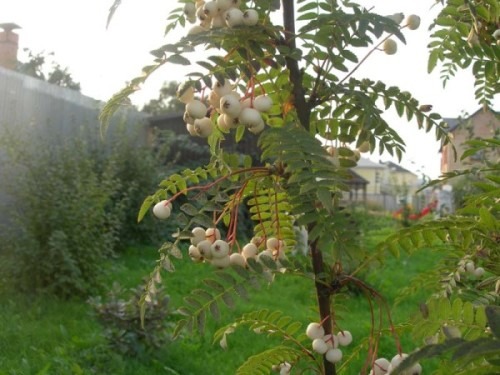
White mountain ash is unpretentious, but loves sunlight and fertile soil
Selection and preparation of planting material
Two-year-old white rowan seedlings are best suited for planting. When choosing planting material, you should pay attention to the following points:
- the root system of the plant must be healthy, not look chapped and dry;
- well developed roots have at least 2-3 large branches over 20 cm long;
- the bark of a healthy plant is not shriveled, but smooth, without cracks and damaged areas.
Before planting, the white rowan seedling is carefully examined, broken and damaged shoots and roots are removed. If the plant is planted in the fall, then the leaves are carefully removed from the branches, while trying not to damage the buds that are in the leaf sinuses.
Landing algorithm
First of all, you should prepare a landing pit for white rowan:
- it is dug out in the form of a square with a side of 60-80 cm, about the same depth is made;
- fill the pit 1/3 with a mixture of peat compost, humus and the top layer of soil, to which 200 g of superphosphate, a handful of ash and 2-3 shovels of rotted manure are added;
- ordinary earth is poured on top up to half the volume;
- pour a bucket of water into the pit and allow it to be completely absorbed.
Next, the plant is planted:
- a white rowan seedling is removed from the container (if the roots are open, they are dipped in a mash made of clay and water);
- install it in the center of the pit and carefully fill the remaining space with soil;
- well compact the earth in the near-trunk circle;
- watering white rowan;
- mulch the soil at the roots with peat, sawdust, hay, straw with a layer of 5-7 cm.
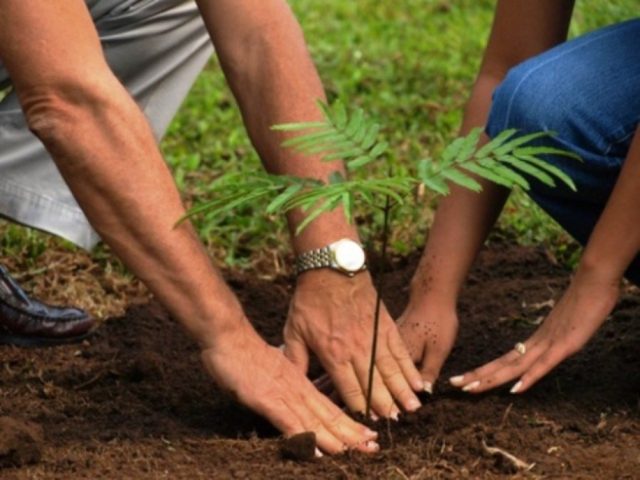
Correct planting of white rowan is a guarantee of tree health
Follow-up care
Caring for white rowan in the garden is easy:
- In dry periods, it is watered. Calculation of water for 1 plant is about 2-3 buckets. Watering is desirable to carry out in the grooves dug along the perimeter of the trunk circle.
- Several times during the season, it is necessary to loosen the soil under the white mountain ash shallowly (no more than 5 cm), simultaneously getting rid of weeds. This is usually done the day after watering or rain. After loosening, the soil is mulched with organic matter.
- Systemic feeding is advised to be produced from the third year of life of mountain ash. They increase its yield. Nitrogen fertilizers - ammonium nitrate, mullein, urea - are applied to the soil in spring; complex, for example, nitroammofosku - in the fall.
- Sanitary pruning is done in early spring and fall to prepare for winter. During this period, dried, diseased and growing branches are removed, the longest shoots are shortened to the upper bud. The crown of an adult plant must be thinned out. To form an umbrella-shaped crown (in particular, in the Kene mountain ash), the shoots that form in the middle of the trunk are blinded from time to time at the very beginning of growth.
- If the white rowan was planted before winter, it is imperative to sprinkle its near-trunk circle with earth. Before the onset of frost, the trunk is insulated with dry tree foliage, coniferous spruce branches, dense agrofibre. In winter with little snow, it is worth additionally covering the plant with snow.
- To protect the trunk of a young tree from rodents, if necessary, a fence made of a fine-mesh metal mesh or special pesticides scattered in the near-trunk circle will help.
Diseases and pests
The species and varieties of white mountain ash are actually quite resistant to diseases and pests. Among the diseases and insects that can infect her are:
Disease / pest name | Signs of defeat | Treatment and prevention measures |
Rust | On the leaves appear yellow spots of a round shape, on the seamy side - pustules of red color with powder of fungal spores | Pruning diseased shoots. Hom, Abiga Peak |
Phylocystic spotting | Ash-gray spots with a wide brown border on leaf plates, premature yellowing and drying of the green mass | Bordeaux mixture (1%), Hom, Abiga-Peak |
Septoria (white spot) | Multiple white spots with a dark border on both sides of the leaf | |
Black necrosis | The bark of the white rowan tree cracks, turns upward, falls behind and falls off in patches, exposing the trunk | Pruning and destruction of diseased branches. Skor, Fundazol |
Green apple aphid | Leaves and petioles curl, shoots bent | Actellik, Karate, Decis |
Rowan gall mite | Green, then - brown numerous tubercles-galls on the leaves | Burning litter. Colloidal sulfur |
Rowan moth | Premature ripening, rotting and falling of berries | Destruction of fallen leaves and berries, loosening the soil under the white mountain ash. Actellic |
Conclusion
White rowan is a bright, unusual ornamental plant that can become a decoration of any garden. Its berries are generally inedible or unpalatable, but this tree or shrub is not grown for the sake of eating the crop. White mountain ash looks great in many landscape compositions - both planted independently and in combination with other trees, shrubs, flowers. Bunches of white berries that appear in the fall usually remain on the branches all winter, allowing the plant to remain decorative almost all year round, invariably attracting admiring glances to itself.
